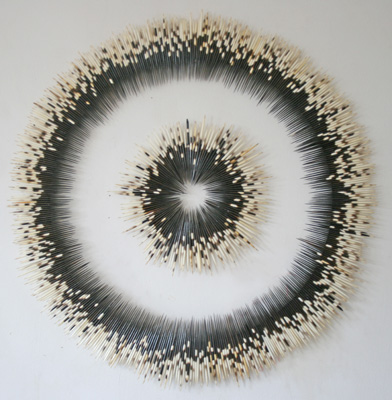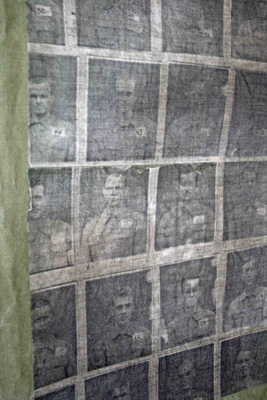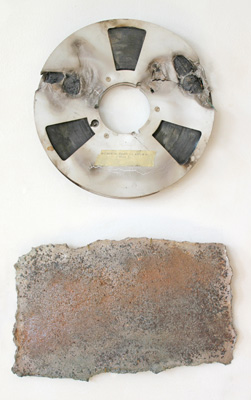 Craft
Craft
All Those Things
We've Forgotten
JORDAN SULLIVAN:
Natural History
UNDERLINE Gallery
238 W 14th St
New York, NY 10011
 n West 14th off of 8th Avenue, the Underline Gallery is tucked into a sleek basement space where Chelsea meets Greenwich Village. Propeller recently stopped by to check out Jordan Sullivan’s show Natural History, on view until June 30. In this cool concrete space, one is met by collages of found pictures on torn book pages no longer resembling the thing in the photos themselves, but abstract objects whose shapes suggest something you can’t quite place—massive porcupine quills arranged in a bulls-eye pattern, and a quartet of 24” by 36” prints hung up with simple straight pins, suggesting the found quality of the images. Natural History suggests a profound sense of working through memory and image. Tucked away into what is normally the gallery’s gifts shop is a sound recording booth where visitors are encouraged to take a few minutes to record their own memories. Propeller chats with Jordan Sullivan about memory, found objects, and the creative process. —Sarah Kruse
n West 14th off of 8th Avenue, the Underline Gallery is tucked into a sleek basement space where Chelsea meets Greenwich Village. Propeller recently stopped by to check out Jordan Sullivan’s show Natural History, on view until June 30. In this cool concrete space, one is met by collages of found pictures on torn book pages no longer resembling the thing in the photos themselves, but abstract objects whose shapes suggest something you can’t quite place—massive porcupine quills arranged in a bulls-eye pattern, and a quartet of 24” by 36” prints hung up with simple straight pins, suggesting the found quality of the images. Natural History suggests a profound sense of working through memory and image. Tucked away into what is normally the gallery’s gifts shop is a sound recording booth where visitors are encouraged to take a few minutes to record their own memories. Propeller chats with Jordan Sullivan about memory, found objects, and the creative process. —Sarah Kruse
PROPELLER: Can you discuss the role that memory plays in your work?
JORDAN SULLIVAN: Memory is so important to my work. I don't know exactly how to explain it, though. It's so abstract. I just know it's there. Memory is this visual thing that isn't material. It's a swarm of images and colors and fragments of words and ideas, this half-burned film reel winding through our brains. I've always wanted to find ways to visualize these things we can't see—memory and emotions and spirituality. I remember in high school my brother brought me to see that movie Memento. I remember this one scene where the main character is asked to remember his wife and he starts reciting these real mundane details before he's asked again to 'really remember her.' The film cuts to just this sequence of fragmented images of her. That always stuck with me and seemed to be such a great visualization of what memory really is—this broken thing, a half-thought, an out of focus picture, some wind through a backyard, a strand of hair in someone's face, a hand tapping against a table, or the second before someone leaves a room.
PROPELLER: You work with a variety of mediums, from collage to ceramics to photography to textiles to found objects. Can you explain the creative process and decisions that go into one of your multi-media pieces?
SULLIVAN: I've always just worked in whatever medium suits the idea or story or picture I'm trying to create. Sometimes I'll just sit with a material or an idea for months before I figure out how I want to make it. It's a lot of sitting and waiting...so much waiting.
PROPELLER: What is your attraction to salvaged materials? How do you go about finding them, and what is your process for selecting them?
SULLIVAN: I grew up in the middle of nowhere in the Midwest, and in the country you really get exposed to sculpture early. As a kid we would rake leaves into piles, we'd build snow forts, or I'd haul bags of cut grass to the cornfield behind our house. By the end of the day there would be these scattered mounds of earth everywhere. When I was a construction worker I got an even greater sense of this. These are all sculptural acts. Almost everything we do is—exchanging money, organizing a shelf, placing flowers over a grave, building a fire. These are all sculptural acts, or acts of transformation, repositioning objects and spaces. Since I was a kid I've always just wanted to build spaces, juxtapose materials, rearrange the pieces until the picture is different. Sculpture is such a great medium for me because it encompasses so much—it's a process of moving pieces from one place to the next. I get so carried away with the idea sometimes that even cleaning the house (pushing dust around) or making the bed or putting away dishes becomes a sculptural act. And I've always been drawn to older, organic, or natural materials—things with history or a life of their own. In the town I grew up in everything was a little old fashioned and antique—there was an old Civil War memorial in the town square and this old cemetery we lived across the street from. There was always junk littered in the woods I used to play in. I'd find old license plates and beer bottles. I was discovering time. When you are a kid and you first start to realize that someone was here before and now they aren't, it's really the most eerie thing. I was always so obsessed with finding old things, digging for fossils and arrowheads. I always wanted to see the past. And the art that you see in weird hillbilly towns like the one I grew up in is so often made from found materials. I remember seeing trees made from hubcaps in people’s front lawns, or flower beds growing in old toilets, or windchimes made from Budweiser bottles. Those images always stuck with me. Now I find things at flea markets, junk stores, the street, the garbage. I like it when my work sort of looks like something you might find on the side of the road.
 PROPELLER: How did you choose the men in the photos for Prayer For The Wounded, which have no names, only numbers? It says these are found photos. How did you find them?
PROPELLER: How did you choose the men in the photos for Prayer For The Wounded, which have no names, only numbers? It says these are found photos. How did you find them?
SULLIVAN: The men in the photographs are American Prisoners of War from World War II. I wanted to create a piece for the soldiers who got lost, who never came home. I made it on a World War II soldier’s duffel bag because that is what a soldier leaves home with. The bag sort of becomes his home, it has all his possessions for a time. But the piece became a bit more broad, and more of a memorial to soldiers and prisoners in general—the sick, the lost, the ones who need the most compassion.
PROPELLER: Do you think your work addresses an idea of dissolution and dislocation? For example, I’m thinking of the enlarged Polaroids that are also obscured and written over, resembling windows, but ones that are smeared, blurred, and marred like memory itself. These pieces seem to suggest the significance of the past, but also that, even in remembering, there is an echo of that which can never be regained.
SULLIVAN: The Polaroids you are referring to are part of a series called Writing To Erase. They were taken by grandmother in 1946. They are of Hitler's house after it was bombed. I rephotographed them and blew them up and painted on them and put ash on them. I wanted to suggest the complexity of memory when it has to do with something like Hitler's home and the war. There are these little poems I wrote on each of the photographs. One of them reads: Are we writing to erase? Are our angels with us? Is it better to forgive, forget, or to have never lived at all? A photograph is at once remembering, altering, and manipulating something.
 PROPELLER: I’m intrigued by your piece Memory Study I (Reels and Pages). The ceramic pieces below each reel evoke both something impenetrable and some undetermined weight to each reel; how were you thinking about your use of these brick-like objects in this piece?
PROPELLER: I’m intrigued by your piece Memory Study I (Reels and Pages). The ceramic pieces below each reel evoke both something impenetrable and some undetermined weight to each reel; how were you thinking about your use of these brick-like objects in this piece?
SULLIVAN: I was really thinking of a way to visualize language or the process of recording. The burned reels contain a recording of my sins or confessions, a recording of the past. The ceramic tablets seem to refer to this older way of recording history and time, and I thought it was interesting to juxtapose them.
PROPELLER: Marcel Proust once said that “as soon as each hour of one’s life has died, it embodies itself in some material object, as do the souls of the dead in certain folk stories, and hides there. There it remains captive, captive forever, unless we should happen on the object, recognize what lies within, call it by its name, and so set it free.” Do you feel that the objects you use in your work somehow have a life that “speaks” or is “set free” by your refiguring them into art pieces?
SULLIVAN: I really am not sure, but that's a great question, and one that I really wanted to explore in this exhibition. Hopefully this work gives new life to certain memories, materials, and objects. I've always been interested in what a person remembers, what he or she forgets, how and why we remember and memorialize, and how those memories come to be at all. And what happens to all those things we've forgotten?
 Sarah Kruse is a staff writer. Jordan Sullivan's "Natural History" can be seen at the Underline Gallery through June 30.
Sarah Kruse is a staff writer. Jordan Sullivan's "Natural History" can be seen at the Underline Gallery through June 30.


